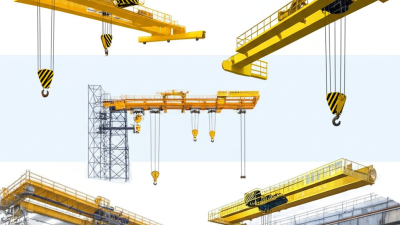Inquiry
Form loading...
-
Phone
-
Wechat

-
Whatsapp

As the industrial landscape evolves, the demand for efficient lifting solutions continues to rise, making the bridge crane an indispensable asset in various sectors. According to a recent market analysis by Grand View Research, the global bridge crane market is projected to grow at a CAGR of 6.1% from 2022 to 2030, driven by advancements in automation and material handling technology. This growth highlights the critical need for industries to evaluate and compare the performance capacity and cost efficiency of different bridge crane types. In 2025, with innovations such as IoT-enabled systems and enhanced safety features, selecting the right bridge crane will not only improve operational productivity but also streamline cost management, making it essential for stakeholders to stay informed about market dynamics and effectively assess their options.

When evaluating bridge cranes, two critical performance metrics emerge as pivotal: load capacity and speed. According to the Hoisting and Rigging Manual by the American Society of Mechanical Engineers (ASME), modern bridge cranes typically have load capacities ranging from 2 tons to over 1,000 tons. This broad range allows industries to select cranes that meet their specific requirements, whether for heavy manufacturing or light assembly tasks. For instance, cranes employed in automotive factories often operate in the 5 to 15-ton capacity range, while those in steel mills may exceed 100 tons, underscoring the necessity for precise capacity evaluations to ensure safety and efficiency.
Speed is another essential factor influencing bridge crane performance. Typical operation speeds vary, with many cranes offering average travel speeds between 100 to 200 feet per minute. However, advanced models equipped with variable frequency drives can achieve greater flexibility, allowing speeds to be adjusted seamlessly based on the task at hand. A report from the Material Handling Industry’s (MHI) 2022 benchmarking study indicated that cranes with optimized speed settings led to a 15% increase in overall productivity in manufacturing operations. This highlights the importance of selecting a bridge crane that not only meets load capacity needs but also enhances operational speed for improved efficiency.
When considering the initial investment and long-term operational costs of bridge cranes, it's crucial to conduct a thorough cost-benefit analysis. Upfront costs can vary significantly based on the type of crane and its specifications, yet the longevity and efficiency of these machines can lead to substantial savings over time. For instance, investing in a higher-capacity crane might seem daunting at first, but its enhanced performance can reduce operational time and labor costs, ultimately making it more cost-effective.
**Tips:** Evaluate the potential return on investment by analyzing the workload requirements and estimating the crane's operational lifespan. Additionally, consider the maintenance costs associated with your preferred models. Implementing advanced technology in crane design can significantly reduce future expenses related to repairs and inefficiencies.
Moreover, with the growing focus on sustainable practices in the construction industry, selecting a bridge crane that incorporates energy-efficient technologies could not only minimize operational costs but also align with environmentally friendly goals. As companies increasingly adopt green innovations, recognizing the full scope of life-cycle costs can yield better financial and sustainability outcomes. By prioritizing cost optimization strategies, businesses can effectively enhance their operational efficiency while contributing to a more sustainable future.
The total ownership costs of a bridge crane are significantly influenced by its maintenance requirements. Regular maintenance not only ensures optimal performance but also extends the lifespan of the equipment. Neglecting maintenance can lead to unexpected breakdowns, resulting in costly downtime that affects productivity. Therefore, understanding the specific maintenance needs of a crane model is critical for effective budget planning and minimizing operational interruptions.
Tips for enhancing maintenance efficiency include scheduling routine inspections and training staff on basic troubleshooting techniques. Additionally, keeping a well-documented maintenance log can help identify recurring issues and inform better long-term strategies. Make sure to invest in quality parts and services, as this can reduce the frequency of repairs and enhance overall reliability.
Another aspect that impacts ownership costs is the availability of spare parts. Choose a bridge crane model with readily available components to ensure quick repairs and minimal downtime. Establishing a relationship with reliable suppliers or service providers can further enhance maintenance efficiency, ultimately leading to cost savings and better performance in your industry operations.
As industries continue to evolve, the integration of automation features in bridge cranes has significantly enhanced operational efficiency and safety. Modern bridge cranes now come equipped with advanced technological solutions, including real-time load monitoring and intuitive control systems. These features simplify complex lifting tasks, allowing operators to manage heavy loads with precision and confidence. By minimizing human error and optimizing workflow, automation transforms traditional lifting operations into streamlined processes, reducing downtime and increasing productivity.
Moreover, the safety enhancements brought about by automation cannot be overstated. Smart sensors and safety interlocks ensure that bridge cranes operate within safe parameters, drastically reducing the risk of accidents. Technologies like predictive maintenance analyze performance data to identify potential issues before they lead to equipment failure. This proactive approach not only safeguards workers but also minimizes costly disruptions. As industries prioritize both safety and efficiency, integrating these innovative features into bridge cranes has become an essential investment for forward-thinking companies looking to stay competitive in today's market.
When it comes to selecting a bridge crane, evaluating both performance and cost efficiency is crucial for industrial operations. Recent industry benchmarks highlight that leading brands demonstrate significant variations in lifting capacities and operational efficiencies. For instance, a report from the Crane Manufacturers Association of America (CMAA) indicates that cranes from Brand A can lift loads up to 35 tons with an efficiency rate of 85%, while Brand B offers systems with a 30-ton capacity but achieves a higher efficiency of 90%. This discrepancy can impact operational productivity and influence long-term investment decisions.
In terms of cost efficiency, a detailed analysis from the Association of American Railroads (AAR) suggests that while initial costs of acquisition may vary, maintenance expenses across brands can offset those differences. Brands that emphasize durable components and offer comprehensive warranty programs tend to perform better in the long run. For example, systems from Brand C, which focus on low lifecycle costs, are reported to have 20% lower maintenance costs compared to traditional models, making them more appealing despite their higher upfront investment. Ultimately, understanding these benchmarks helps businesses make informed purchasing decisions that align with their operational goals.
